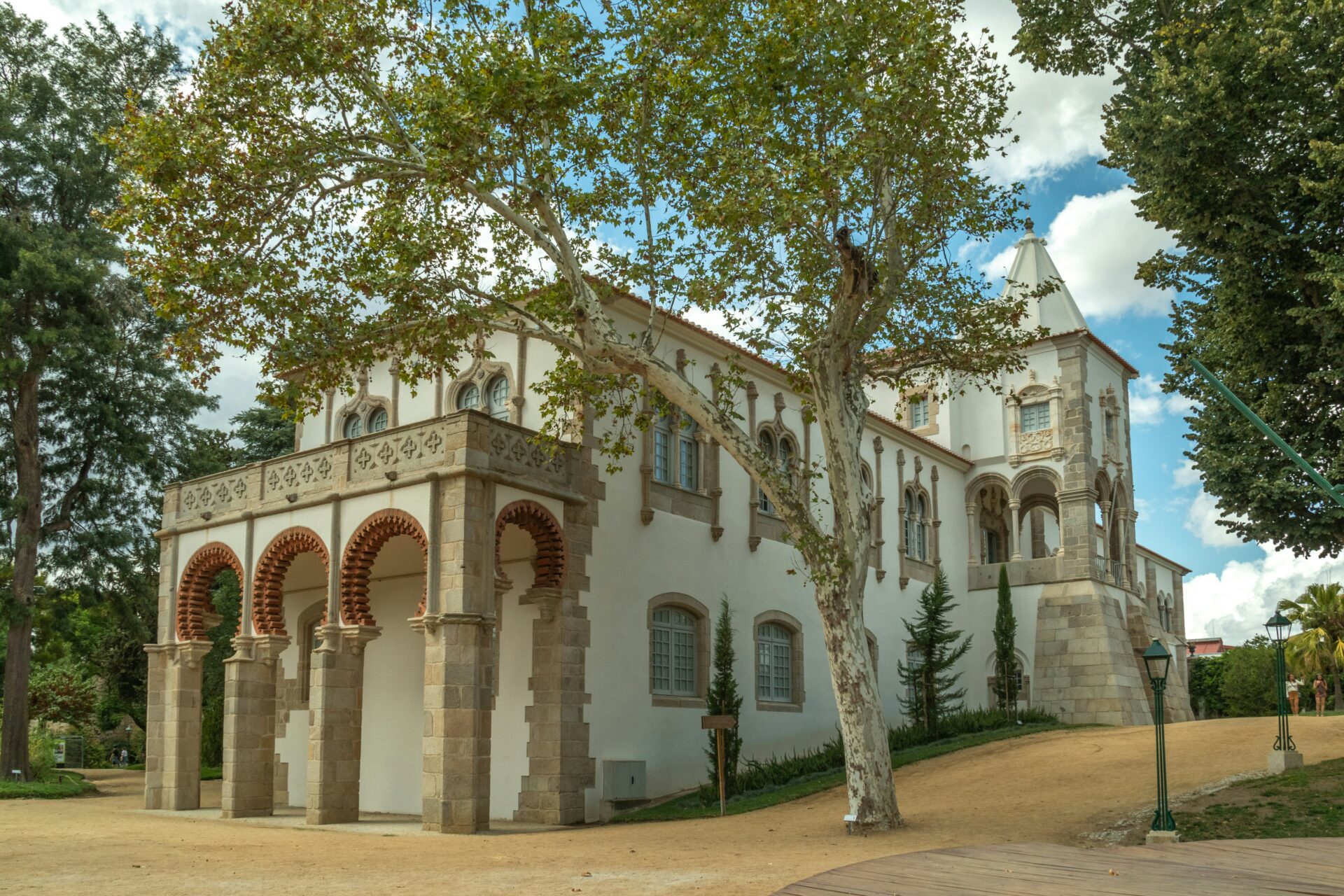Nestled in the heart of Portugal’s Alentejo region, Évora captivated me from the moment I wandered into its medieval streets. This museum-city’s fascinating history stretches back to Roman times, but it truly flourished in the 15th century when Portuguese kings chose it as their residence.
Walking through Évora’s narrow streets lined with charming white houses reveals why UNESCO declared its historic center a World Heritage Site in 1986.
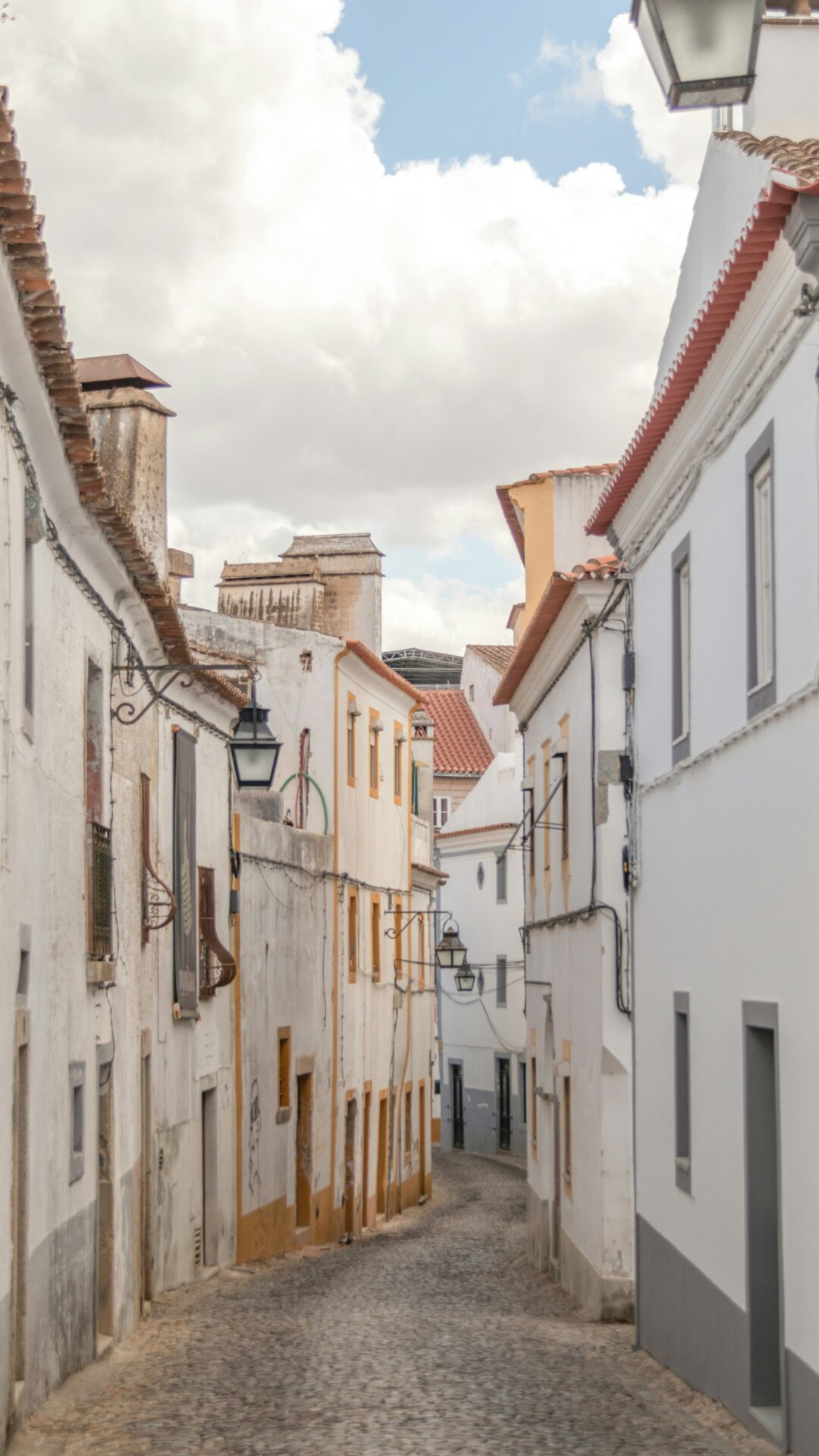
I spent days exploring this compact city on foot, discovering ancient monuments at every turn. The blend of Roman ruins, Gothic cathedrals, and Renaissance palaces tells the story of Portugal’s golden era.
While Lisbon and Porto often steal the spotlight, Évora offers a more intimate glimpse into authentic Portuguese culture without the crowds.

My journey through Évora connected me with Portugal’s soul in ways I hadn’t experienced elsewhere. The city’s well-preserved medieval core, combined with its relaxed pace and rich cultural heritage, makes it an essential stop for anyone wanting to understand Portugal beyond its coastal attractions. I’ll never forget sipping local wine in a centuries-old square as the setting sun painted those white-washed buildings in golden hues.
Unveiling Évora’s Rich History
Évora’s fascinating past spans over two millennia, with layers of civilization leaving their mark on this beautiful Portuguese city. The city’s historical journey takes us from ancient Roman settlements to its golden era as a royal residence.
Roman Roots and Medieval Mastery
Walking through Évora today, I can still see the impressive Roman Temple, locally known as the Temple of Diana. This well-preserved 1st-century structure stands as a testament to Évora’s Roman origins when the city was called Liberalitas Julia.
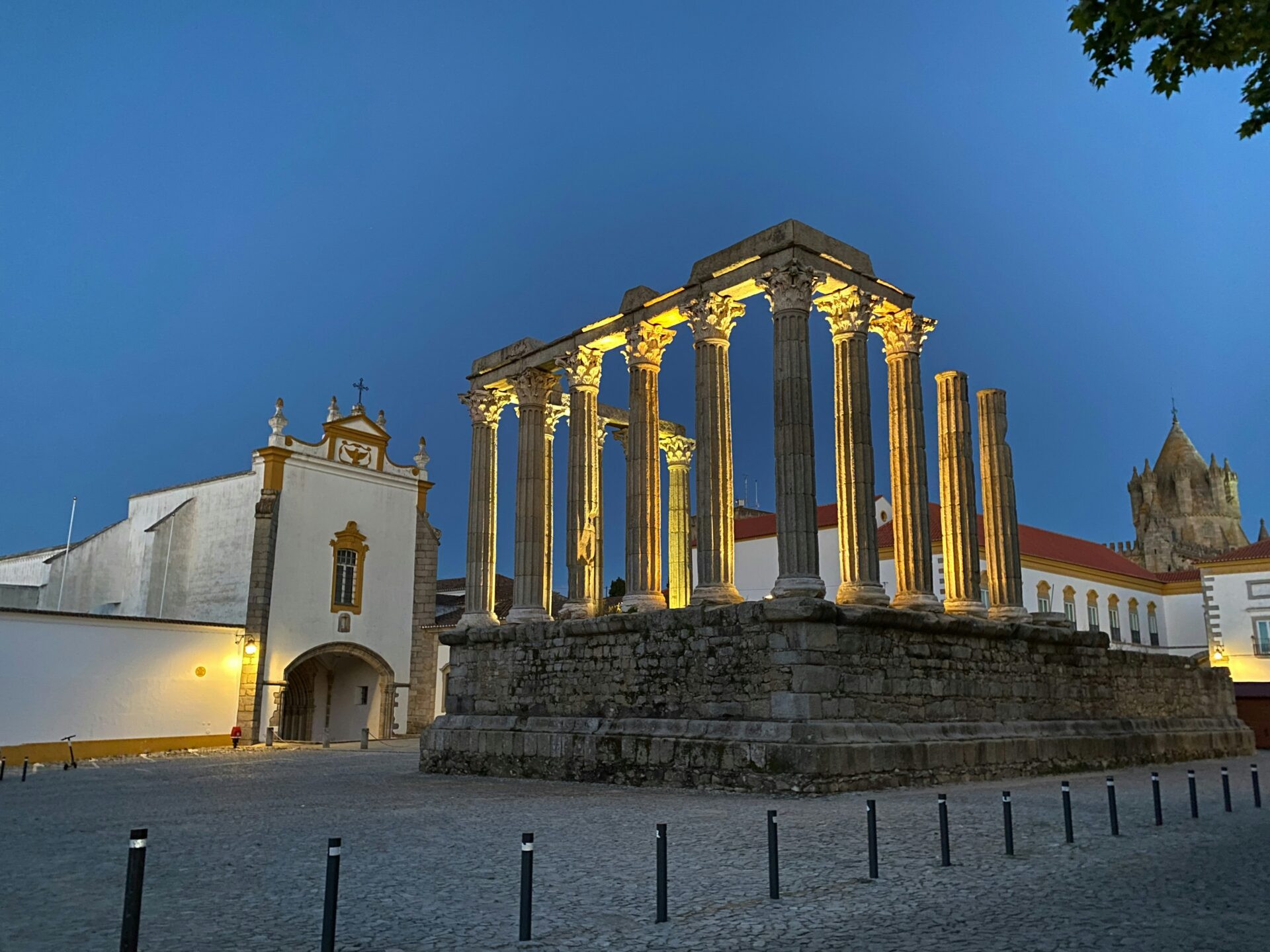
After the Roman period, Évora fell under Moorish control for over four centuries. I love how you can still see this influence in the city’s narrow, winding streets and architectural details.
The Christian reconquest in 1165 marked a new chapter. King Afonso I incorporated Évora into the Portuguese kingdom, and soon, religious orders began establishing themselves here. The magnificent Évora Cathedral, started in the 12th century, shows the city’s medieval importance.
Golden Age of Portuguese Discovery
The 15th century brought Évora’s most splendid era when Portuguese kings chose it as their royal residence. I’m always amazed by the architectural treasures from this period, including the Royal Palace and the Church of São Francisco with its famous Chapel of Bones.
University life flourished here too. Founded in 1559, the University of Évora became a center of learning and culture that attracted scholars from across Europe.
The wealth from Portuguese maritime expeditions flowed into Évora, funding beautiful palaces and mansions. Noble families built elegant homes throughout the city, many adorned with intricate Manueline decorations – Portugal’s unique architectural style during the Age of Discovery.
Architectural Wonders of Évora
Évora’s skyline tells the story of Portugal’s rich history through its magnificent buildings. Walking through the narrow cobblestone streets, I discovered architectural treasures spanning Roman times to the Renaissance period.
The Dramatic Évora Cathedral
The Évora Cathedral (Sé de Évora) took my breath away with its imposing granite presence. Built between 1186 and 1250, this fortress-like structure showcases a fascinating mix of Romanesque and Gothic styles.
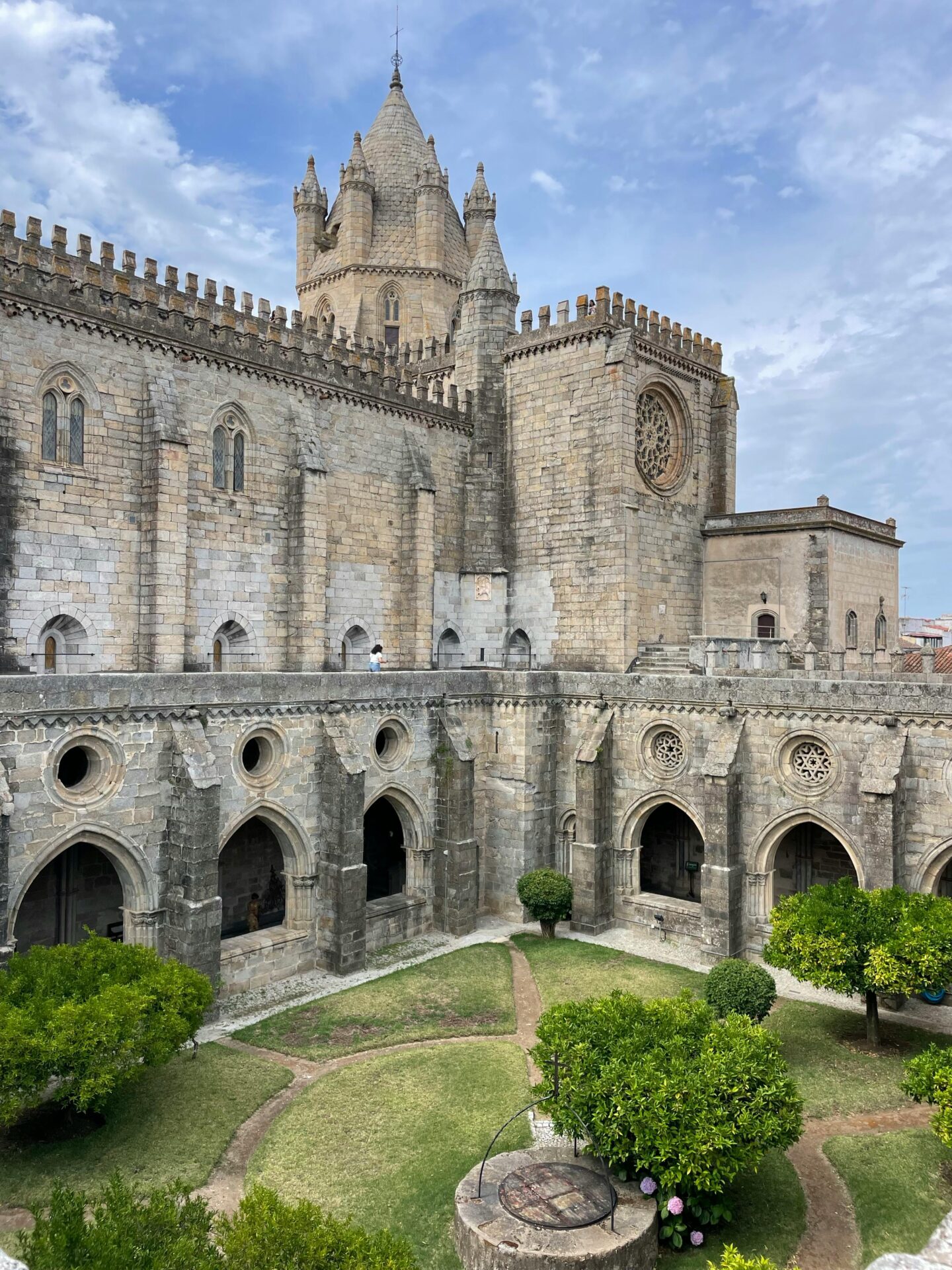
The cathedral’s most striking feature is its asymmetrical towers. One is topped with a beautiful dome while the other has cone-shaped spires.
Inside, I marveled at the marble pillars and the 14th-century statue of a pregnant Virgin Mary—quite rare in religious art.
The cathedral’s cloisters are worth exploring, with Gothic arches framing a peaceful courtyard. I recommend climbing to the rooftop terrace for stunning views across Évora’s terracotta rooftops and surrounding Alentejo plains.
Templo Romano: A Glimpse into Antiquity
Standing proudly in Évora’s historic center is the Templo Romano, often called the Temple of Diana. Dating back to the 1st century AD, this ancient Roman temple is remarkably well-preserved with 14 original Corinthian columns still intact.
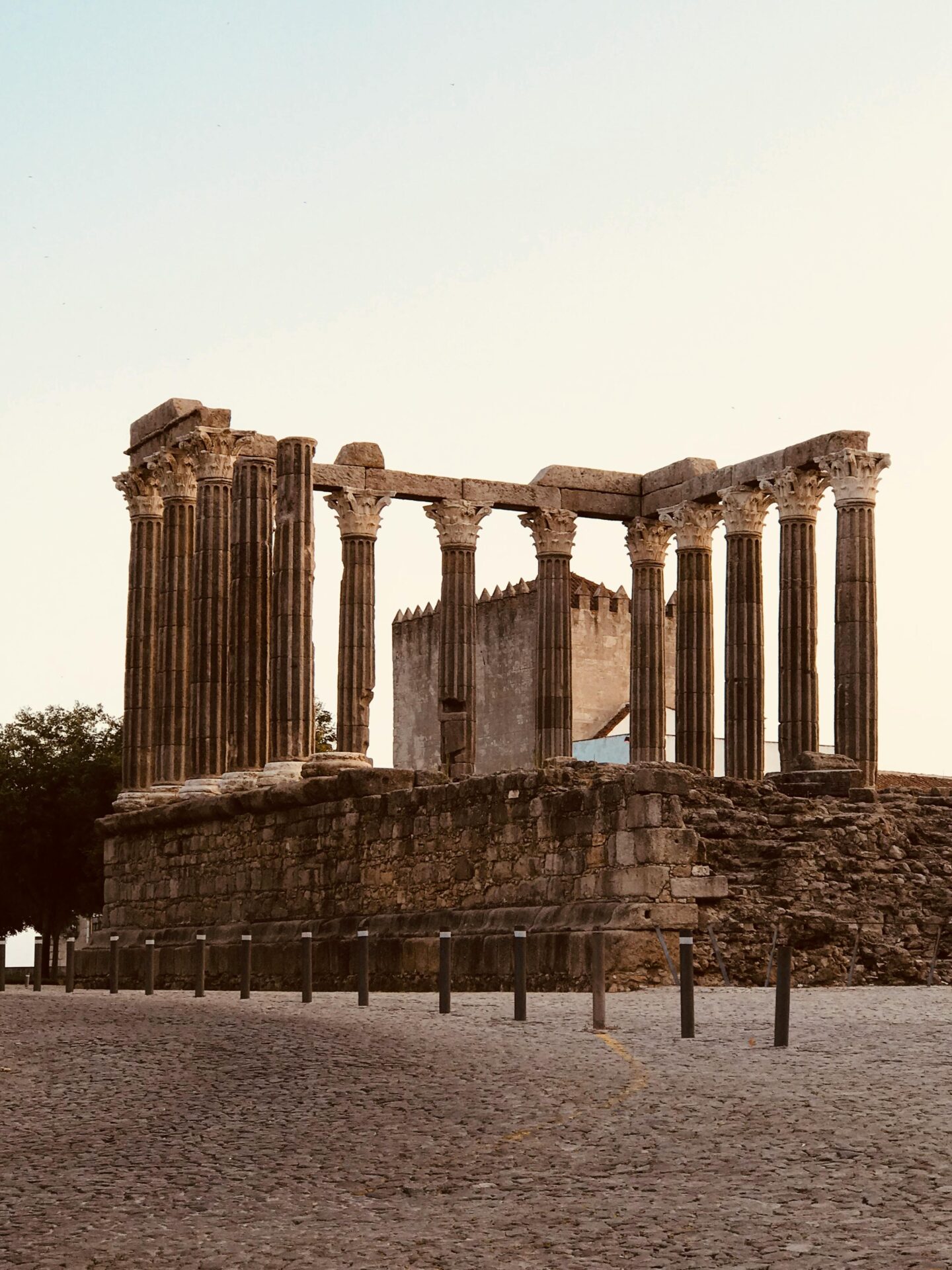
The temple’s survival is miraculous—it was once incorporated into a medieval building that protected it from destruction. Today, it stands as Portugal’s best-preserved Roman structure.
At sunset, the temple is particularly magical when golden light bathes the ancient stones. I spent an evening sitting nearby, imagining Roman citizens gathering here 2,000 years ago. The temple’s elegant columns against Évora’s whitewashed buildings create one of Portugal’s most iconic views.
The Mysterious Chapel of Bones
The Capela dos Ossos (Chapel of Bones) offers Évora’s most unusual architectural experience. Built in the 16th century by Franciscan monks, this small chapel’s walls and pillars are entirely decorated with human bones and skulls.
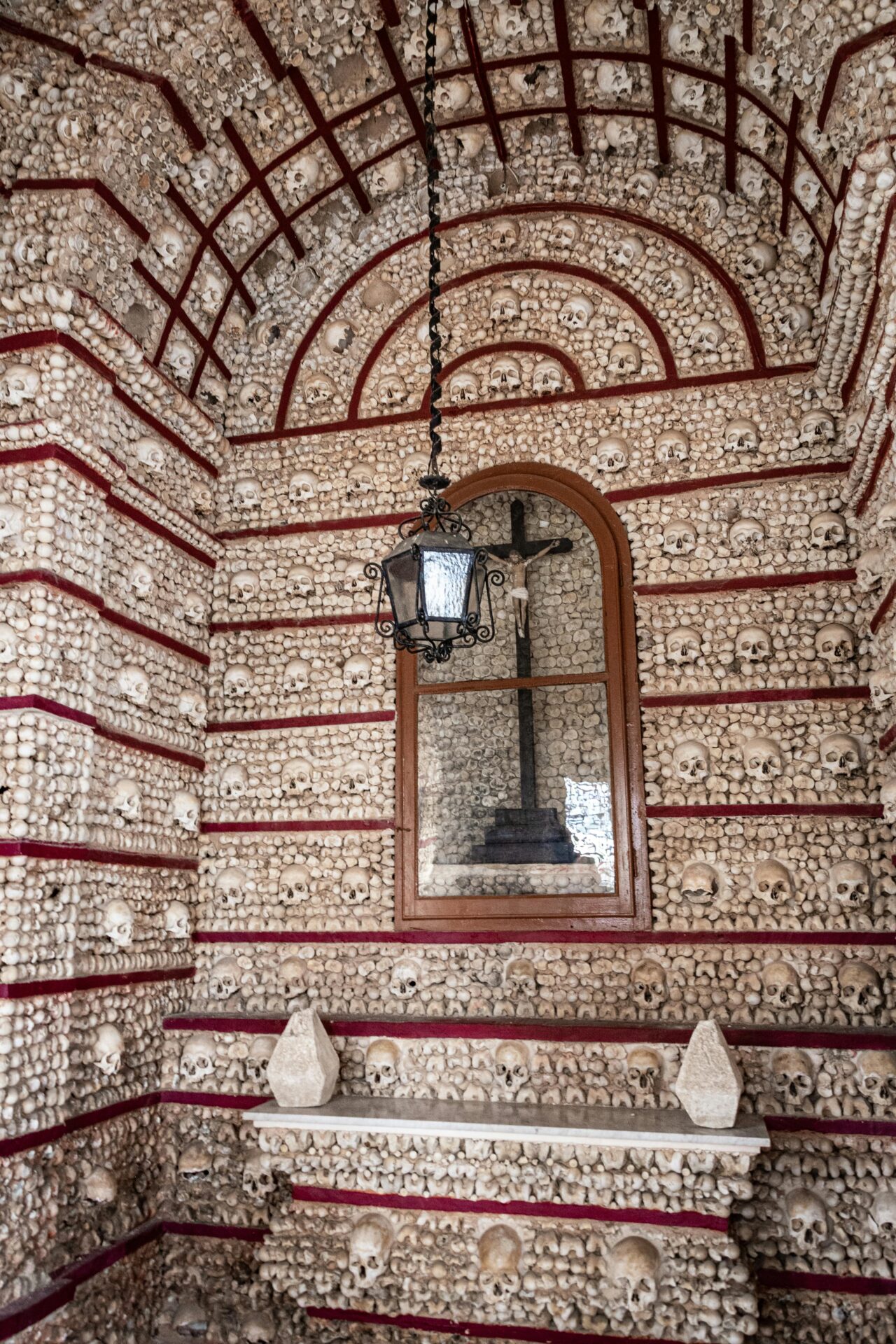
The entrance bears a haunting inscription: “We bones that are here, for yours await.” Inside, I found myself surrounded by the remains of around 5,000 monks, arranged in patterns across the walls and ceiling.
Despite its macabre nature, the chapel feels strangely peaceful. The monks created it as a memento mori—a reminder of life’s temporary nature. Sunlight streams through small windows, creating an atmospheric play of light and shadow across the bone-covered walls.
This unique sacred space is unlike anything else in Portugal and offers a powerful meditation on mortality.
Cultural Tapestry
Évora’s cultural heritage runs deep through its cobblestone streets and historic buildings. The city blends centuries of artistic traditions with modern expressions, creating a vibrant cultural scene that visitors can experience throughout the year.
Vibrant Arts and Craft Scene
Walking through Évora, I discovered countless artisans preserving traditional crafts. The region is famous for its handmade tapestry rugs, especially from nearby Arraiolos village. These colorful works tell stories through intricate patterns passed down through generations.
Local pottery workshops create beautiful pieces inspired by the Alentejo landscape. Many studios welcome visitors to watch artisans at work or even try their hand at creating something.
Cork art is another distinctive craft here. Since Alentejo produces much of the world’s cork, artisans transform this sustainable material into everything from practical household items to stunning decorative pieces.
Annual Festivals and Events
Évora comes alive during its many cultural celebrations throughout the year. The Fair of São João in June is one of the most important, featuring traditional music, dance performances, and local food stalls selling regional specialties.
During Easter, the city hosts solemn religious processions that wind through the historic center. The contrast of flickering candles against ancient stone walls creates an unforgettable atmosphere.
I particularly enjoyed the Évora Classical Music Festival held in historic venues like the Roman Temple and medieval churches. The acoustics in these ancient spaces add another dimension to already beautiful performances.
Food festivals celebrate Alentejo’s culinary heritage with opportunities to taste regional wines, cheeses, bread, and olive oil – all essential elements of local cultural identity.
Culinary Delights and Local Treats
Évora’s food scene is a journey through Portugal’s rich culinary heritage. The Alentejo region offers some of the country’s most distinctive flavors, with dishes that tell stories of local traditions and incredible wines that showcase the region’s terroir.
Tasting Traditional Alentejan Cuisine
I discovered that Alentejo cooking is hearty, rustic, and incredibly flavorful. The region’s signature dish is açorda alentejana – a bread soup flavored with garlic, coriander, olive oil, and poached eggs. It’s simple yet deeply satisfying.
Don’t miss the black pork (porco preto), raised on acorns in the surrounding oak forests. The flavor is unlike any pork I’ve tasted elsewhere.
For cheese lovers, Évora’s Queijo de Évora is a must-try. This sheep’s milk cheese has protected designation status and pairs perfectly with local bread.
Street food is also delightful here. I enjoyed sampling the pastéis de nata (custard tarts) from local bakeries, though they have their own regional twist compared to Lisbon’s versions.
Wine Tasting in Alentejo’s Vineyards
Alentejo produces some of Portugal’s most celebrated wines, and Évora makes the perfect base for exploring local vineyards. The region specializes in robust reds made from native grapes like Aragonez, Trincadeira, and Alicante Bouschet.

I visited several wineries just outside the city where tastings often include local cheeses and bread. Many offer tours explaining how the region’s hot, dry climate creates wines with deep flavors and smooth tannins.
Herdade do Esporão and Adega da Cartuxa are two standout wineries near Évora. Both offer excellent tasting experiences where you can learn about traditional wine-making methods while sampling their award-winning bottles.
The local wine shops in Évora’s historic center also offer tastings if you can’t make it to a vineyard. Ask for recommendations – locals are passionate about sharing their wine knowledge!
Planning Your Visit
Getting to Évora and enjoying your time there takes some planning. The city offers different experiences throughout the year, with options for moving around efficiently and ways to travel responsibly.
Best Time to Explore Évora
I’ve found that spring (April-June) and fall (September-October) offer the most pleasant weather for exploring Évora. Summer temperatures regularly climb above 90°F (32°C), making those cobblestone walks rather challenging.

Winter brings fewer tourists and lower prices, but some attractions may have reduced hours. If you’re interested in local festivals, plan your visit during June for the São João Fair or December for the enchanting Christmas markets.
The city gets quite busy during Portuguese holidays and summer weekends. I recommend visiting mid-week if possible for a more relaxed experience with shorter lines at popular sites like the Chapel of Bones and Roman Temple.
Getting Around the City
Évora’s historic center is compact and best explored on foot. Most major attractions sit within the medieval walls in an area you can cross in about 30 minutes. Comfortable walking shoes are essential for those uneven cobblestone streets!
For trips to outlying areas like the megalithic sites:
- Local buses run regularly, but with limited schedules
- Taxis are readily available and reasonably priced
- Rental bikes offer flexibility (€15-20/day)
Parking inside the walls is extremely limited, so if you’re arriving by car, use one of the free parking lots just outside the city walls. I usually park near Porta de Aviz and enjoy the short walk into the historic center.
Tips for Sustainable Travel
I make it a point to support local businesses when visiting Évora. The region’s sustainable tourism initiatives focus on preserving both cultural heritage and natural resources.

Some eco-friendly practices to consider:
- Bring a reusable water bottle. (Tap water is safe to drink.)
- Shop at the local farmers’ market for regional products.
- Stay in locally-owned accommodations rather than chain hotels.
- Try vegetarian versions of traditional Alentejo dishes.
The city has implemented several walking-only zones to reduce pollution. Take advantage of these car-free areas to experience Évora’s authentic atmosphere. Many local tour guides now offer specialized sustainability-focused tours. These tours highlight the region’s ecological practices and organic wine production.

